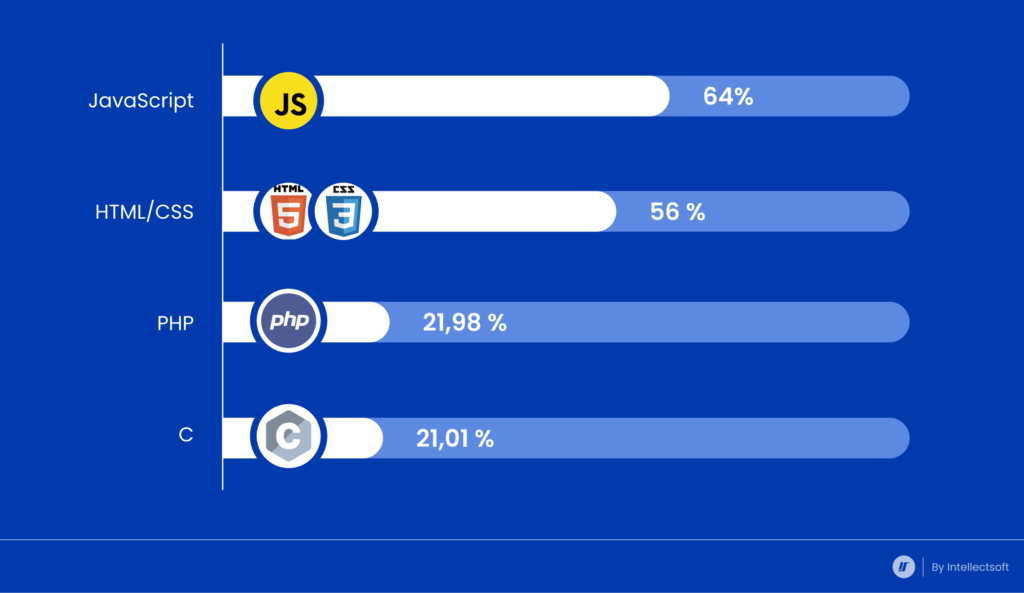The variety of most used languages among software developers remains huge. As Statista indicates, every fifth developer uses at least one of 12 different programming languages, ranging from JavaScript (64%) and HTML/CSS (56%) to PHP (21,98%) and C (21,01%).

In the given circumstances, staying up to date with the trends in software development is a big part of being a good developer, and it’s important to keep tabs on the most popular backend frameworks that developers are using and adjust to the new requirements fast.
This article covers 7 backend frameworks that are popular in 2022, along with some helpful tips about which one might be right for you based on your experience level and other factors.
What Are Backend Frameworks?
In essence, a backend framework provides a standardized, reusable structure for creating applications. A framework can speed up development by providing ready-made solutions for common tasks, such as connecting databases or allowing user logins.
Much like WordPress or Drupal can streamline a website’s creation process, a backend framework makes it easy to build complex applications quickly.
Why Use Backend Frameworks? Their Importance
Developers can use frameworks to save time when building new software. Even more, a backend framework provides an architecture that encompasses all necessary components of your platform, which makes a web service possible.
When you consider what it takes to develop every part of a web service yourself, it’s easy to see why so many companies choose to use these technologies. And the list of the most popular backend frameworks appeared as the result of frequent usage of 7 software architecture approaches that have proved their effectiveness and flexibility by 2022.

7 Most Popular Backend Frameworks in 2022
There are several different types of frameworks available for developers on various platforms such as .NET, Java, Python, and Ruby. Choosing which one will work best for your business depends upon its specific needs at any given moment.
For example, some platforms offer more flexibility to apply different features to different applications. Other considerations may include how big your organization is and how much support is provided by each provider. You may also want to look into whether or not your current team uses a particular programming language so that the framework you’ve chosen has the relevant language and can be adopted.
Once you have reviewed these factors, you should have a better idea of which direction you would like to take next with regard to selecting an appropriate backend framework.
And our guide here will help reveal the advantages and disadvantages of most popular backend frameworks:
- Django
- Ruby on Rails
- Laravel
- ASP.NET
- Flutter
- NodeJS
- Golang
Django from Python
Founded by two Python developers, Django’s creators envisioned it as a toolkit for building scalable web applications quickly. And they certainly hit their mark with millions of developers around the world using Django today. The framework has undergone several major changes over its lifetime, however, ensuring that it stays up-to-date with industry trends and stays relevant.
Advantages:
- Usability: It’s easy to master and start using Django for your project.
- Rich functionality: Your app can get several great functions with this pick among the most popular backend frameworks. Also, you can use it for various purposes, including building platforms, messengers, and analytical tools.
- Scalability: Django from Python is a good choice if your website is expected to experience high demand spikes.
- Security: The framework has in-built protection from the most common security challenges and a secure procedure of user authentication.
Disadvantages:
- Limitations: This most popular backend framework has low flexibility when it comes to introducing new features. The deployment stage also requires following prescribed patterns only.
- Need for planning. Even though it’s easy to start with Django, its application requires tremendous effort, mastery, and extensive planning.
Ruby on Rails
Though it’s been around for almost two decades, Ruby on Rails continues to be one of, if not the most, popular backend frameworks today. Its biggest advantage is that it scales well as your business grows — in fact, it was designed with growth and scalability in mind. As a result, Ruby on Rails can support your project over time with minimal coding changes or redesigns; by nature, it’s very malleable.
Advantages:
- Speed: Almost every part of your software can have its pre-built plugin or module, so building it will be really fast.
- Transparency: Ruby on Rails standardizes everything, so your project will have minimum complexity and maximum consistency.
- Free of charge: As an open-source framework, Ruby on Rails is free to use for anyone, and its purpose-built modules library is easy to get.
Disadvantages:
- Cannot handle high demand: If your business will grow to handle hundreds of thousands of requests per second, you should use another framework from the very beginning.
- Standardized features only: Since this representative of backend web frameworks defines not only functions but also dependencies between them in one way only, it's hard to implement something unusual with it. Also, it means that each mistake will cost you extra money on ruining dependencies and building everything from scratch.
Laravel
Released in 2011, Laravel is one of PHP’s most popular frameworks for developing web applications. Also known as Larajole after its creator Taylor Otwell, Laravel is a platform-agnostic framework that can be used to build applications of any scale using Object-Oriented Programming (OOP) techniques. Notable features include it uses namespaces, auto-loading facilities, template engines that can be extended using plugins, extensive documentation, and microservice support.
Advantages:
- Several useful pre-built features: With Laravel, you can rely on this framework for user authentication, API integrations with mailing services, and notifications. The process is simple and easy to use.
- Caching tools and log handling: You can use Redis and Memcached for caching data, along with multiple log handlers.
- Tools for testing: Laravel has PHP support and phpunit.xml file that enable simulation of users’ behavior for testing purposes.
Disadvantages:
- Complicated: It’s hard to learn Laravel due to numerous complex and strict rules you need to follow.
- Lack of support: Due to the growing problems, support from Laravel is not always available.
ASP.NET
As a Windows-based most popular backend framework for web development, ASP.NET was developed by Microsoft back in 2000 and is primarily based on C#. Nowadays, it’s constantly being upgraded with new features that come directly from Microsoft. As a consequence, Visual Studio plays an essential role because of its cross-platform compatibility.
Advantages:
- Minimum coding: Most functions are pre-configured in ASP.NET core already, which facilitates and speeds up development.
- Cross-platform: Based on C#, ASP.NET works well for making cross-platform web apps. Also, despite being very popular in enterprise applications, it’s also quite customizable when needed.
Disadvantages
- Lack of control: Developers’ freedom and creativity are limited by Microsoft’s rules and control over their actions when they work with ASP.NET.
- Price for licensing: Not only additional but also basic Core modules require licensing.
Flutter
Flutter is the most popular backend framework for making apps for Android and iOS. Flutter’s biggest advantage is that it allows you to use a single codebase, which means you spend less time maintaining two different apps. This also means any changes you make only have to be made once, and they will instantly appear on both platforms.
Advantages:
- Wide applicability: Flutter is the best backend framework for mobile development. At the same time, its application is not limited to Android and iOS only — you can use it for building apps on Windows, Linux, Mac, and Google Fuchsia.
- Fast changes: You don’t need to reboot an app to test updates as Flutter allows changes on the running code.
Disadvantages:
- Compatibility problems: Flutter overhauls with the release of iOS and Android upgrades.
NodeJS
Node.js is an open-source, cross-platform JavaScript runtime environment for developing server-side web applications. Node.js uses an event-driven, non-blocking I/O model that makes it lightweight and efficient, perfect for data-intensive real-time applications that run across distributed devices.
Advantages:
- Error handling: With the throw-catch approach, NodeJS detects errors and corrects them immediately.
- Easy to learn: JavaScript is the most used programming language in the world, which makes it easier to master NodeJS even with basic JavaScript knowledge.
Disadvantages:
- Event-callback mechanism: In NodeJS, everything should be done in a linear order, which prevents concurrency.
Golang
Go is a simple, clean, efficient programming language created at Google. It’s so popular that it’s already supported by major cloud providers like Heroku and AWS. It’s hard to find Golang among the most common backend frameworks yet, but its popularity is increasing and it’s compatible with NodeJS already.
Advantages:
- Concurrency: Golang is a great fit for large software projects, as its lightweight thread communication mechanism handles running several functions at once.
- Scalability: With goroutines, Go handles parallel threads effectively and reliably.
Disadvantages
- Complicated: As the new language, Go is hard to learn and possesses numerous specific rules and procedures.
How to Choose Among the Most Popular Backend Frameworks?
As you can see, the task of getting the right one among the best backend frameworks can be tough. In addition to mastering the various requirements, you should take into consideration your current needs and predict your future development to make the right choice.
If this task seems tough for you, feel free to contact a dedicated development team from Intellectsoft and request our help! With this service, you can delegate several areas of responsibilities within a software development project to us, including
- Resource planning
- Team composing
- Staff motivation
- IT infrastructure
- Relevant training, and many more.
Talk to our experts, and let us help you pick the best among the most popular backend frameworks!


